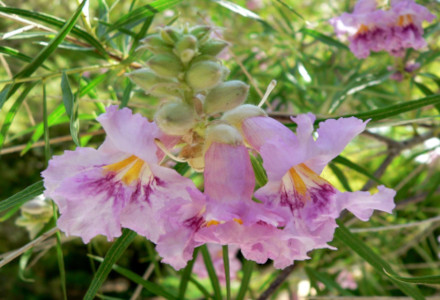
Desert Willow Facts
- This gorgeous variety of flora most frequently goes by the simultaneously descriptive yet deceptive common name of the Desert Willow. It does have at least one other general title, though. That’s the extremely similar term of Desert-willow, however.
- Within scientific circles, though, the plant’s usually better known by its formal appelation. Thankfully, that’s a relatively simple term to pronounce for the layperson. That’s because this marvel of Nature holds the formal moniker of Chilopsis linearis.
- Official credit for the original recognition of it as a separate and distinction species remains somewhat murky. Typically, that accomplishment is assigned to both the Spanish botanist Antonio José Cavanilles, and the English botanist Robert Sweet.
- Regardless of which name one chooses to use, or any dispute over recognition, it remains an impressive flora. Despite its name, it’s not actually a type of willow. Instead, it’s really a member of another Family of flowering plants, known as catalpa.
- Fortunately, the gorgeous Desert Willow appears to be maintaing a population base that’s both stable and sufficient. That pleasant trend further seems to hold true throughout the entirety of its native range. The IUCN thus lists it as Least Concern.
- Nonetheless, it does face some potential threats to its continued existence as a species. Like many species, most of these stem from human activities. They include factors such as habitat degradation and outright loss. Climate change also poses a severe danger.
Related Articles
Desert Willow Physical Description
The Desert Willow immediately captures the attention of those fortunate to encounter it in the wild. It doesn’t just do so due to its visual appeal, though, but also because of a unique attribute. The flora is extremely variable in terms of the size it attains at maturity.
Because of the extent of those variations, this fabulous flora sometimes develops as a moderate-sized shrub. Yet other specimens attain height qualifying them as a small tree. Though this principal certainly isn’t uncommon in Nature, it rarely appears to this extent.
Individual examples of this wonder of evolution sometimes only reach about (1.5 m) in height. Others, meanwhile, attain more impressive statures of up to as much as 40 ft (12.2 m). That variation even occurs between specimens located in the same local environment.
The trunk develops as relatively slender in shape. It also generally develops a twisted, leaning design. The bark of each tree most often presents a smooth texture, and shows a light or moderate brown shade. In smaller examples, this may develop as a light green hue.
The leaves of the dazzling Desert Willow also merit appreciation for their nature. This deciduous foliage develops as willow-like in structure, thus the common name. In color, this distinctive foliage typically shows varying shades of both light and bright green coloring.
These also each mature with a curved, linear design. Like the trunk, these also achieve widely differing lenghts between specimens. They range in length from 4 – 12 in (10.2 – 30.5 cm). Yet they remain quite slim, only averaging about 0.3 in (0.8 cm) in their width.
- Kingdom: Plantae
- Phylum: Tracheophyta
- Class: Magnoliopsida
- Family: Bignoniaceae
- Genus: Chilopsis
- Species: C. linearis
Desert Willow Distribution, Habitat, and Ecology
Regrettably, the breathtaking Desert Willow evolved as native to only a moderate swathe of the globe. The precise region in which it appears, however, might surprise some people. In general, this beautiful variety of flora developed as endemic to part of North America.
Yet, within that overall area, it only lives in certain portions. The majority of its population makes its home in the southwestern part of the United States. From there, its territory extends into the northern sections of Mexico. It’s unknown if it ever lives beyond this range.
The plant also evolved very specific preferences for its choice of habitat. That’s another unexpected aspect of its nature, though. This holds true because, instead of a temperate climate like one might expect, the shrub evolved as native to very arid regions.
Even within this ecosystem, it needs precise and unusual conditions. It lives almost exclusively in areas of desert washes or near sandy streams. The tree also holds a preference for altitudes. It rarely appears at heights greater than 5,000 ft (1,500 m) above sea level.
Given where it lives, the appropriately-named Desert Willow typically achieves pollination via the actions of specific local insect species. That important group is mainly comprised of larger bee species, such as various types of locally prevalent bumblebees and carpenter bees.
Generally, the plant blooms between May and September. Following the completion of blooming, the small fruit appears. This develops in an elongated pod up to 13.8 in (35 cm) in length. Each of these structures contains a large number of small, winged seeds.
Species Sharing Its Range
Check out our other articles on 3 Surprising Sahara Desert Sites, Harp Seal, Mount Vesuvius, Bluespotted Ribbontail Ray, Franklin’s Bumblebee, Santa Rosa Island Manzanita

